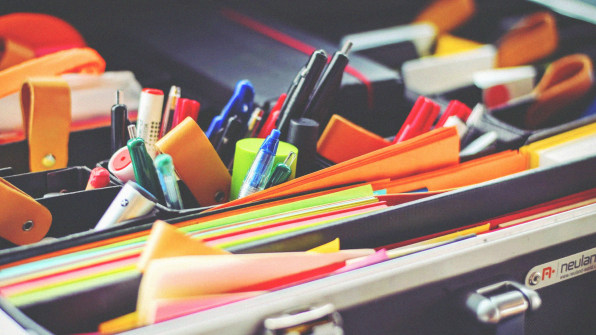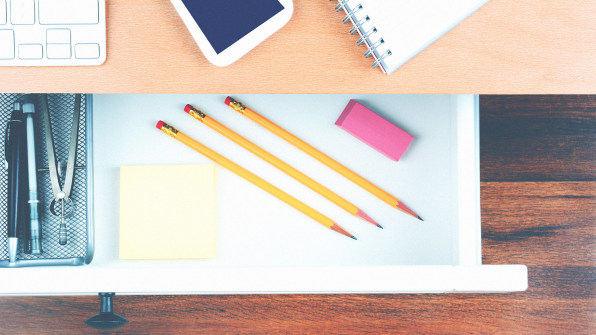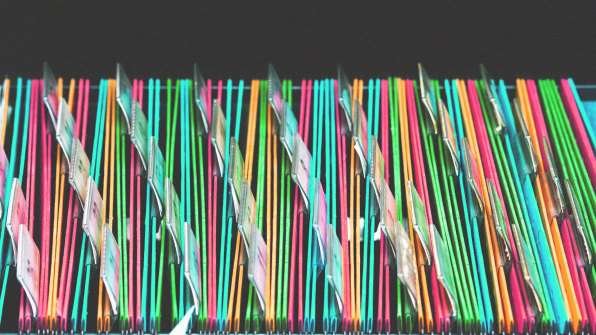How to Make a Desk With a Drawer
A desk drawer can be a beautiful thing that makes your work seem enjoyable, or a black hole of chaos that frustrates you every time you open it. After all, how you feel about your workspace affects your productivity more than you might think.
During my former career in home-decorating magazines, I learned a thing or two about how to set up drawer space efficiently. Here are a few tips to get you started:

Be Ruthless About What Needs To Be On Your Desk
Before you even yank open your desk drawer and start thinking about how to reorganize it, you first need to decide what should be on your desktop. Drawers can help you declutter the surface of your workspace, but they often suffer as a result: The mess that isn't out in front of you is hiding just out of view, causing trouble despite being out of sight.
Related: Three Ways Your Workspace Is Quietly Hurting Your Productivity
So ask yourself: What really needs to be in front of you at all times? For me, that's a computer, printer, teacup, and glass of water. Beyond that I have few inspirational items in a corner that make me smile, as well as one glass holding pens, highlighters, and scissors—all items that are both easy to grab and put away. My daily to-do list always travels with me so if I'm at my desk, that's there too.
You might find that you'll need a lot less than that. If you have a lot more, you may want to reconsider your office necessities overall, or find a way to relocate whatever desktop clutter might be staring at you to a small piece of real estate elsewhere in your office, like a stacked "in" and "out" box in a corner.
Take An Inventory
Once you've figured out what you want on your desk, then it's time to explore your drawer space. If you're like most office workers, you'll find that you've forgotten about most items in your drawers. So this step is easy: Pull them all out and arrange everything inside your drawers into one of these four categories:
- trash
- recycling
- supply closet
- desk drawers
Take your time here–knowing what to purge and what to stash away takes some time. But when you're done, you'll be left with only relevant items that you need and use on a regular basis.

Organize Your Drawers By Items You Use Most To Least
In the small top drawer of your desk, on the side of your dominant hand, arrange the items that you use in the next order of frequency after the items on your desktop. In my top right-hand drawer, I have items like tape, a stapler, Post-Its, paperclips, and rubber bands.
This is the one drawer in my desk where I also have a shallow in-drawer organizer. That's helpful for things like keeping the paper clips or pushpins from getting mixed with the rubber bands. An important note: All the desk organizers in the world won't necessarily save your drawers from disaster. They're helpful for small items, but if you add an organizer into all your drawers, it'll just incentivize you to hang onto more small items than you probably need to.
Related: Nine Myths About Being Organized That Keep You Surrounded In Clutter
You can find a variety of desk-drawer organizers at office supply stores, Amazon, Target, and the like. If you've got a streak of craftiness in you, Pinterest has ample supply of ideas. When you pick out your organizer, you'll obviously want to make sure that the width and depth works with your drawer. But you should also pay special attention to the height. You want to have an organizer that can hold your items and still allow you to easily open and shut the drawers without the office supplies getting stuck on the top edge of the desk.
Set Aside A Drawer For Large Items
You'll want to have another drawer for some of the large items that you could place on your desk but can just as easily be tucked away. I use the top left drawer of my desk for that function; it holds spare printer paper and empty file folders. I also use that drawer for my Skype headset as well as a label maker, which I became a fan of after reading David Allen's Getting Things Done.

If You Have Room, Start A File-Folder Drawer
If you have a drawer wide and deep enough for file folders, you've hit the jackpot. Yes, it's 2017, and some of your most important documents are backed up on your hard drive or in the cloud. But there are still real benefits to keeping some of your current working documents in hard copy–just inside your desk, rather than on top of it. If nothing else, this keeps them handy so you can quickly retrieve those resources when it's time to go to a meeting, work on a project, or jump on an impromptu call.
But the key to making this system work is that once those files are no longer immediately relevant, you should recycle or shred them. To avoid clutter, make sure your file-folder drawer is a living organism, not a fossil-bed for all the work you've ever done.
Organize All Other Drawers By Function
Finally, arrange any remaining desk drawers by function. I find it useful to have a drawer for mail items as well as a finance drawer. My mail drawer consists of blank cards, thank-you notes, special-occasion cards, return-address labels, envelopes, and stamps. In my finance drawer, I have a fire-safe box with my passport, checkbooks, and other important documents. If there's a particular task you do frequently at your work that requires special supplies, try to group them in the same drawer so that you can open one drawer and access all those function-specific items once.
Bottom line: your desk–inside and out–should help you stay productive, not slow you down.
How to Make a Desk With a Drawer
Source: https://www.fastcompany.com/40458598/this-is-how-to-organize-your-messy-desk-drawers-at-work